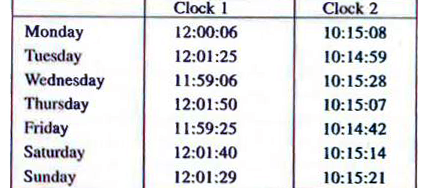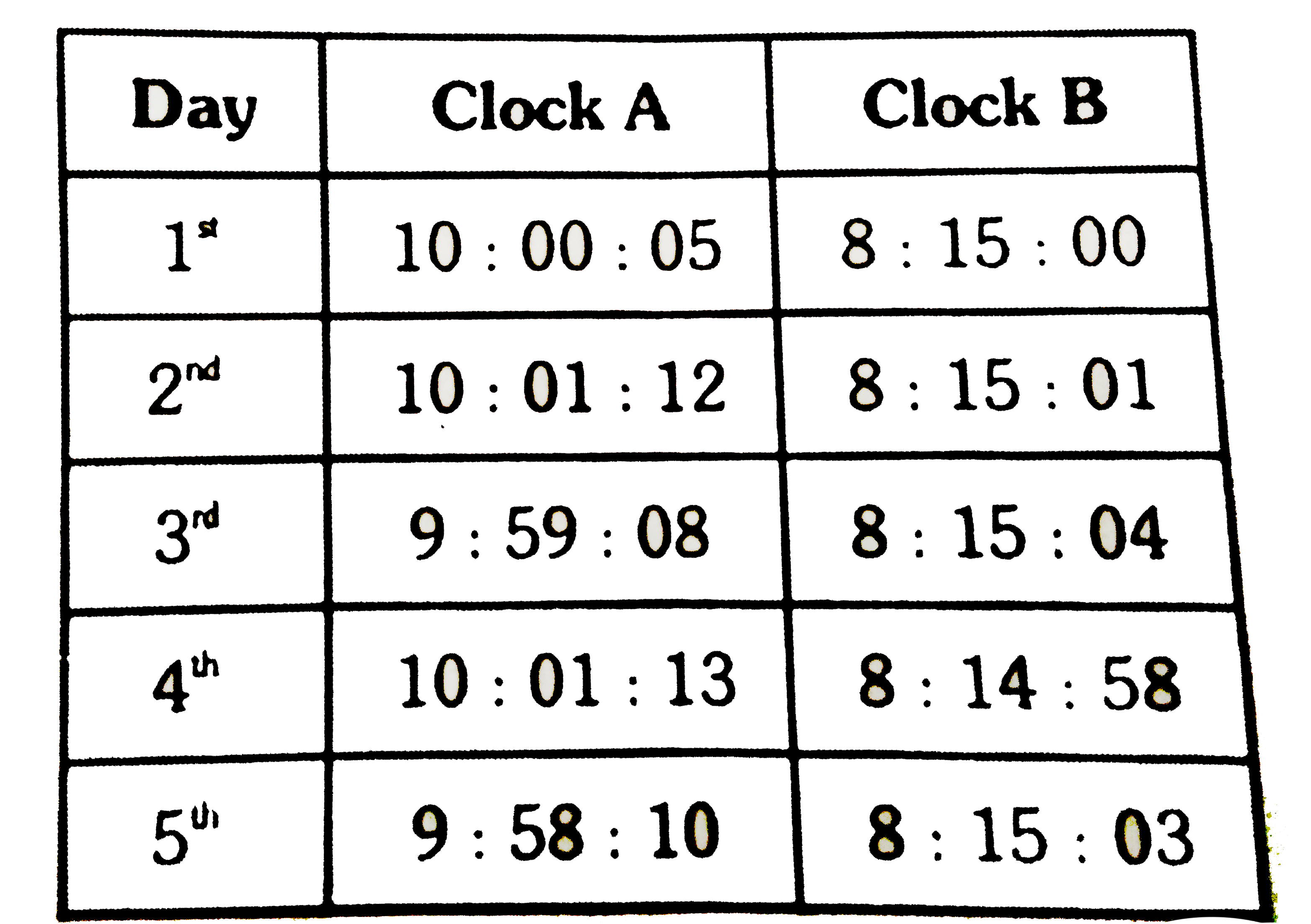Two clocks are being tested against a standard clock located in a national laboratory. At 12:00:00 noon by the standard clock, the readings of the two clocks are :

If you are doing an experiment that requires 'precision time interval' measurements , which of the two clocks will you prefer ?
The range of viriation over the Neven days of observations is 164s for clock-1. and 32 s for clock 2. The average reading of clock I is much closer to the standard time than the average reading of clock 2.
The important point is that a clock is zero error is not as significant tor precision work as its variation. because a zero -error can always be easily corrected . Hence clock 2 is to be preferred to clock 1.
Topper's Solved these Questions
- BOOK - AAKASH SERIESCHAPTER - UNITS AND MEASUREMENTSEXERCISE - EXERCISE -1 A187videos
UNITS AND MEASUREMENTS
- BOOK - AAKASH SERIESCHAPTER - UNITS AND MEASUREMENTSEXERCISE - EXERCISE- 1 B28videos
UNITS AND MEASUREMENTS
- BOOK - AAKASH SERIESCHAPTER - UNITS AND MEASUREMENTSEXERCISE - QUESTIONS FOR DESCRIPTIVE ANSWERS7videos
UNITS AND MEASUREMENTS
- BOOK - AAKASH SERIESCHAPTER - UNITS AND MEASUREMENTEXERCISE - PRACTICE EXERCISE45videos
UNITS AND MEASUREMENT
- BOOK - AAKASH SERIESCHAPTER - WAVE MOTIONEXERCISE - PRACTICE SHEET ADVANCED (INTEGER TYPE QUESTIONS)10videos
WAVE MOTION
Similar Questions
Atomic clock generally used in the national standards, is based on the periodic vibrations produced in a
06:35View SolutionGibbs-Helmoholtz equation relates the free energy change to the enthalpy and entropy changes of the process as
(ΔG)PT=ΔH−TΔS
The magnitude of ΔH does not change much with the change in temperature but the energy factor TΔS changes appreciably. Thus, spontaneity of a process depends very much on temperature.
The dissolution of CaCl2.6H2O in a large volume of water is endothermic to the extent of 3.5kcalmol−1. For the reaction. CaCl2(s)+6H2O(l)→CaCl2.6H2O(s)ΔHis−23.2kcal. The heat of solution of anhydrous CaCI2 in large quantity of water will beView SolutionIn the formula X=3YZ2 , X and Z have dimensions of capacitance and magnetic induction respectively . What are the dimensions of Y in MESQ system ?
06:35View SolutionThe ratio of S.I unit of the C.G.S unit of gravitational constant 'G' is-
06:20View SolutionA source emitting sound of frequency 180 Hz is placed in front of a wall at a distance of 2 m from it. A detector is also placed in front of the wall at the same distance from it. Find the minimum distance between the source and the detector for which the detector detects a maximum of sound. Speed of sound in air =360ms−1.
 View Solution
View SolutionTwo clocks are being tested against a standard clock located in a national laboratory. At 12:00:00 noon by the standard clock, the readings of the two clocks are :
Clock 1Clock 2Monday12:00:0510:15:06Tuesday12:01:1510:14:59Wednesday11:59:0810:15:18Thursday12:01:5010:15:07Friday11:59:1510:14:53Saturday12:01:3010:15:24Sunday12:01:1910:15:11
If you are doing an experiment that requires precision time interval measurements, which of the two clocks will you prefer ?View SolutionTwo clocks are being tsted against a standard clock located in the national laboratory. At 10:00:00 AM by the standard clock, the readings of the clocks are :

If you are doing an experiment that requires prescision time interval measurements, which of the two clock will you prefer ?
(a) Clock A
(b) Clock B
(c) Either Clock A or B
(d) Neithr A nor BView Solutionराष्ट्रीय प्रयोगशाला में स्थित एक मानक घड़ी से तुलना करके दो घड़ियों की जाँच की जा रही है । मानक घड़ी जब दोपहर के 12:00:00 का समय दर्शाती है, तो इन दो घड़ियों के पाठ्यांक इस प्रकार है :

यदि आप कोई ऐसा प्रयोग कर रहे हो जिसके लिए आपको परिशुद्ध समय अंतराल मापन की आवश्यकता है, तो इनमें से आप किस घड़ी को वरीयता देंगे ? क्यों ?04:52View Solutionराष्टीय प्रयोगशाला में स्थित एक मानक घडी से तुलना करके दो पहाड़ियों की जांच की जा रही है। मानक घडी जब दोपहर के 12:00:00 का समय दर्शाती है तो इस दो घडियो के पाठ्यांक इस प्रकार है -

यदि आप कोई प्रयोग कर रहे हो जिसके लिए आपको परिशुद्ध समय अंतराल मापन की आवश्यकता है, तो इसमें से आप किस घडी को वरीयता देंगे, क्यों ?06:11View SolutionTwo clocks are being tested against a standard clock located in a national laboratory . At 12:00:00 noon by the standard clock, the regarding of the two clocks are : If you are doing an experiment that requires precision time interval measurements, which of the two clocks will you prefer ?
06:11View SolutionTwo clocks are being tested against a standard clock located in a national laboratory . At 12:00:00 noon by the standard clock, the regarding of the two clocks are : If you are doing an experiment that requires precision time interval measurements, which of the two clocks will you prefer ?
03:55View SolutionTwo clocks are being tested against a standard clock located in a national laboratory . At 12:00:00 noon by the standard clock, the regarding of the two clocks are : If you are doing an experiment that requires precision time interval measurements, which of the two clocks will you prefer ?
02:50View SolutionTwo clocks are being tested against a standard clock located in a national laboratory. At 12:00:00 noon by the standard clock, the readings of the two clocks are : If you are doing an experiment that requires 'precision time interval' measurements , which of the two clocks will you prefer ?
03:56View SolutionTwo clocks are being tested against a standard clock located in a national laboratory. At 12:00:00 noon by the standard clock , the readings of the two clocks are : If you are doing an experiment that requires 'precision time interval' measurements, which of the two clocks will you prefer? c
View SolutionTwo clocks are being tested against a standard clock located in a national laboratory. At 12:00:00 noon by the standard clock , the readings of the two clocks are :

If you are doing an experiment that requires 'precision time interval' measurements, which of the two clocks will you prefer? c02:38View SolutionTwo clocks are being tested against a standard clock located in a national laboratory. At 12:00:00 noon by the standard clock, the readings of the two clocks are :
Clock1Clock 2Monday12:00:05:10:15:06Tuesday12:01:1510:14:18Wednesday11:59:0810:15:18Thursday12:01:5010:15:07Friday11:59:1510:14:53Saturday12:01:3010:15:24Sunday12:01:1910:15:11Sunday12:01:1910:15:11
If you are doing an experiment that requires precision time interval measurements, which of the two clocks will you prefer? The range of variation in time of clock ?02:31View Solution
